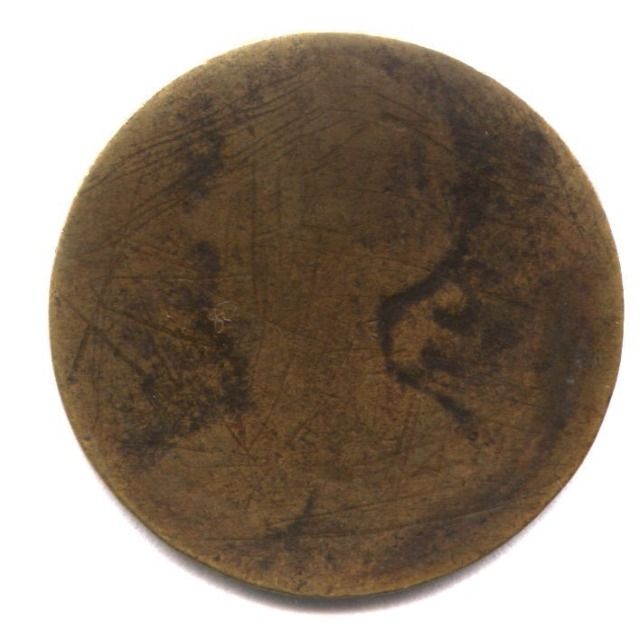Options
What to do while waiting for FrankenStorm? Why, buy **TWO** BLACKSMITH TOKEN!
I love eBay. Now that I've had a few days to begin studying Canadian Blacksmith Tokens, I am impressed by their scarcity. With the exception of Wood 33, the one I first bought, these are quite difficult to locate even with the resources of eBay and the Internet. Maybe I've seen a dozen for sale? They are making the Vermonts look "common".  ~~~~~. When Wood cataloged these in 1910 frankly even he seemed baffled by them. In trying to classify them, he found many to group together either through metal composition or muling. This NewP is part of the second group, which resemble the first group but are cruder and struck on thin brass planchets. This piece is Wood 14 BL-10. Despite its shocking appearance I think this grades VG. For the rarity and esoteric interest here I think this was a great buy for $26. After having routinely spent 3 and 4 figures for Vermonts.... This is a real treat! So Fellow Numismatists feast your eyes on this Unusual and Esoteric piece. Canadian Blacksmith Token Wood 14 BL-10, struck circa 1830-40.
~~~~~. When Wood cataloged these in 1910 frankly even he seemed baffled by them. In trying to classify them, he found many to group together either through metal composition or muling. This NewP is part of the second group, which resemble the first group but are cruder and struck on thin brass planchets. This piece is Wood 14 BL-10. Despite its shocking appearance I think this grades VG. For the rarity and esoteric interest here I think this was a great buy for $26. After having routinely spent 3 and 4 figures for Vermonts.... This is a real treat! So Fellow Numismatists feast your eyes on this Unusual and Esoteric piece. Canadian Blacksmith Token Wood 14 BL-10, struck circa 1830-40. 
 While this coin IS worn the line drawing of 14 shows us how little "detail" actually EVER existed on the coin. They were made to look old and worn, fresh off the die!
While this coin IS worn the line drawing of 14 shows us how little "detail" actually EVER existed on the coin. They were made to look old and worn, fresh off the die! 

 While this coin IS worn the line drawing of 14 shows us how little "detail" actually EVER existed on the coin. They were made to look old and worn, fresh off the die!
While this coin IS worn the line drawing of 14 shows us how little "detail" actually EVER existed on the coin. They were made to look old and worn, fresh off the die! 
0
Comments
What were these tokens used for, commerce? Ive never heard of a blacksmith token before.
Dead Cat Waltz Exonumia
"Coin collecting for outcasts..."
Blacksmith Coppers - Introduction
Sort of like coin boards: They can be super rare and still very cheap.
I'm sure putting together a complete set is impossible (again, sort of like coin boards), but how many varieties are known? I love rare esoteric stuff like this.
<< <i>This one is Wood 4 BL-3. This is a copper strike and has nice reverse detail. >>
You do realize how hilarious that sounds.
I have at least a couple of Blacksmith coppers, one I'm quite confident is a Wood-11 and another I'm sure is a Wood 12. I found them in an old cloth bag of large coppers (about three dozen worn copper pieces mostly with early 19th century dates) that I picked up at a second-hand store earlier this year. The lady who sold me the bag of coppers said she had purchased it from a man who found it in a barn "up north," which probably means somewhere in northern NY between Syracuse and the Canadian border.
I'm quite encouraged that you judge the one you just purchased to be VG, as mine show even more detail without any marks.
The bag also contained a bunch of Canadian tokens, a Vermonts copper, a New Jersey copper, a bunch of old Irish coins/tokens, a Machins Mills copper (or it may be a cast counterfeit of a Georgivs II 1/2 penny), some hard times tokens, and about a dozen that I haven't been able to identify.
It's fascinating stuff, and I'd welcome any additional information about these issues that you or anyone else cares to post!
<< <i>That's a great score, a bag of old Coppers. People "dream" about that happening! So two Blacksmiths out of a total of how many? I cannot see any more than a few percent overall survival on these.q]
My three Blacksmiths came from a bag of more than 100 pieces. Many are foreign coppers that I really haven't taken a good look at: Canadian Bank tokens, British large pennies and half pennies, French dix centimes, dos reales coppers (Argentina?), some Mexican, Greek, Asian, US and Canadian large cents, etc. Some are holed, some bent, some worn almost smooth. Mostly pre-1900.
It appears to me that the bag I bought contained a mix of pieces that circulated along both sides of the St. Lawrence River during the same period in the mid-19th century, plus a bunch of other foreign "novelties" (not all copper) that someone added to the mix much later.
Very interesting stuff about which I know little.